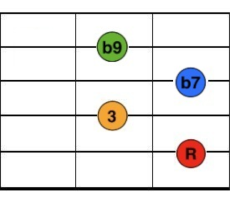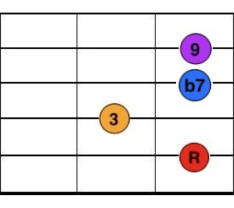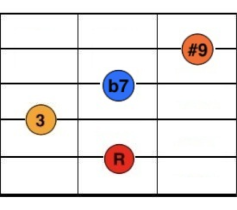Learn About Chord Extensions In This Blues Guitar Theory Lesson
In this article I want to shed some light on an important lesson to be learned in blues guitar theory: the concept of chord extensions. Most guitarists use the same chords all the time when they play blues rhythm guitar parts. That’s why it’s so important to learn about these chord extensions. Imagine a painter that only uses one color when painting, as the same thing happens if we would only use on type of chord in our guitar playing; we get stuck into producing the same sounds over and over again.
The function of this theory lesson would be for you to see and understand all the different options that are avalaible. All the chords we’ll look at can be substituted from one another, giving you more options for creative chord use. We’ll start of with the regular dominant 7th chord and expand to other chords to illustrate how chord extensions work.
In the regular dominant 7th chord (such as the D7 chord) we have four pitches:
- the root (R)
- the third (3)
- the fifth (5) (we can leave this pitch out)
- the flat seven (b7)
It’s important to visualize these pitches on the neck of the guitar. That’s why I created colored chord diagrams below. In the chord diagram for the D7 chord you’ll find all the pitches, except for the fifth that isn’t present in this chord. I have color-coded these pitches in the following manner:
- the root (R) = red
- the third (3) = yellow
- the fifth (5) = not present in this chord
- the flat seven (b7) = blue
3 5
D7
As you can see there are two root notes present in this chord. When we play dominant chords in this way, we are changing the chord extension that is located on the B-string. To clarify this, let’s look at the D7b9 chord (spelled out in words: ‘D seven flat nine’).
The Dominant Seventh Flat Nine Chord
In the case of this dominant seventh chord the added flat nine becomes our extension, so we are playing the following pitches:
- the root (R) = red
- the third (3) = yellow
- the fifth (5) = not present here
- the flat seven (b7) = blue
- the flat9 (b9) = green

3 5
D7b9
These pitches are structured here so that the extensions represent the top note of the chord.
Watch the movement of this top note on the B-string. In the example of the D7 chord we played the root here (which in this case is the D note of course, since the root note determines the name of the chord), while in this D7b9 chord we play the b9 (flat nine) here (which is the Eb note in this case). It’s important to realize that this D7b9 chord can be used as a substitute of the regular D7 chord, as is the case with all the other chords we’ll look at in this lesson.
The Dominant Ninth Chord
In the ninth chord the pitches are structured in this way:
- the root (R) = red
- the third (3) = yellow
- the fifth (5) = not present here
- the flat seven (b7) = blue
- the ninth (9) = purple
This dominant ninth chord is often just called the ‘ninth chord’, is one of the chords that we can play instead of the good old dominant seventh chord. So whenever you come across a regular seventh chord such as the A7, you can choose to use the A9 instead. Since this ninth chord produces a very jazzy feel, it’s the perfect thing to do when you are looking for this kind of mood in your chords.

3 5
D9
The Dominant Seventh Sharp Nine Chord
Another chord that is worth looking at is the 7#9 chord, otherwise known as the ‘Jimi Hendrix ‘chord (because Jimi Hendrix used this chord a lot; listen to tracks such as Purple Haze).
- the root (R) = red
- the third (3) = yellow
- the fifth (5) = not present here
- the flat seven (b7) = blue
- the sharp ninth (#9) = orange

3 5
D7#9
As you can hear when you play this chord, this #9 extension adds some ‘bite’ to the chord. There’s a certain agressiveness present, that’s why this chord is used a lot in electric blues as well as rock music. Remember that you can insert any of these chords instead of the normal seventh chord.
Play these chords on your guitar and watch what is going on on the B-string, since the extensions are located on this string. These extensions ‘color’ our chords, so learning to apply them opens up new flavours and/or colors (whatever you want to call it) in your playing.
Master Blues Guitar With My Online Guitar Lessons
